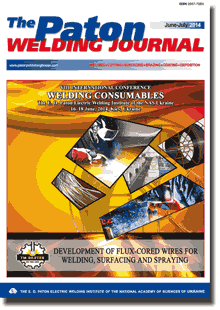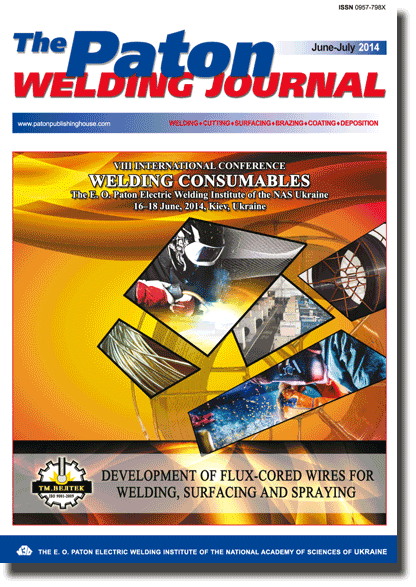Access for download PDF files for subscribers and for reviewers of scientometric bases.
Organization: Elsevier for content access(PDF files of journals released before 2024 are available for download from the website's archives))
Organization: Elsevier for content access(PDF files of journals released before 2024 are available for download from the website's archives))
| 2014 №06 (17) |
DOI of Article 10.15407/tpwj2014.06.18 |
2014 №06 (19) |

The Paton Welding Journal, 2014, #6-7, 87-91 pages
FLUX FOR ELECTRIC ARC SURFACING PROVIDING HIGH-TEMPERATURE REMOVAL OF SLAG COATING
N.M. STRELENKO1, L.A. ZHDANOV1 and I.A. GONCHAROV2
1NTUU «Kiev Polytechnic Institute». 37 Pobeda Ave., 03056, Kiev, Ukraine. E-mail:strelenkon@gmail.com
2E.O. Paton Electric Welding Institute, NASU. 11 Bozhenko Str., 03680, Kiev, Ukraine. E-mail: office@paton.kiev.ua
Abstract
It was shown as a result of analysis of mechanisms of slag crust removal from the weld metal surface that the spinels at slag-metal interface and their intergrowth have the main influence on this process. It was found on the basis of analysis of structure of spinels and slag melt that to prevent the formation of spinels at the interface and intergrowth of metal and slag, it is necessary to provide the presence in the slag melt of a structural element with configuration of a linked structure, differed from tetra- and octahedral structures, and not capable to formation of spinels. It was established that prevention of formation of spinels in providing necessary welding-technological properties of flux of SiO2-Al2O3-MgO-CaF2 system can be attained at adding of zirconium oxide in the amount of 3.5-5.5 % into flux composition. The flux has been developed, which provides a spontaneous removal of slag coating at high temperatures. 13 Ref., 6 Figures.
Keywords: submerged arc surfacing, high-temperature removal of slag coating, metal-slag interface, complex compounds of oxides, spinels, zirconium oxide, slag systems
Received: 29.04.14
Published: 28.09.14
References
1. Zhdanov, L.A., Strelenko, N.M., Zvorykin, K.O. et al. (2010) Physical-chemical peculiarities of slag crust removal from weld metal surface and procedural base of evaluation methods. Tekhnolog. Sistemy, 1, 109-115.
2. Pokhodnya, I.K., Yavdoshchin, I.R., Karmanov, V.I. et al. (1974) Mechanism of adhesion of slag crust with weld surface. Avtomatich. Svarka, 5, 5-9.
3. Moravetsky, S.I. (2011) Detachability of slag crust in arc welding (Review). Pt 1: Mechanism of chemical adhesion of slag crust to weld metal. The Paton Welding J., 1, 28-31.
4. Moravetsky, S.I. (2011) Detachability of slag crust in arc welding (Review). Pt2: Character of the effect of main factors on detachability of slag crust. Ibid., 2, 20-23.
5. Ignatov, M.N., Ignatova, A.M., Naumov, S.V. et al. (2012) Study of relationship between thermal expansion coefficients of weld metal and welding slags and temperature in range of 100-1000°C. Obrabotka Metallov, 56(3), 116-119.
6. Zubchenko, A.S., Koloskov, M.M., Kashirsky, Yu.V. et al. (2003) Handbook of steel and alloy grades. Moscow: Mashinostroenie.
7. Strelenko, N.M., Zhdanov, L.A. (2012) Specifics of formation of spinels on slag-metal interface in submerged-arc welding. Visnyk Donbas. Mashynobud. Akademii, 28(3), 260-263.
8. Novikov, V.K. (1987) Development of polymer model of silicate melts. Rasplavy, 6(1), 21-23.
9. Novikov, V.K., Nevidimov, V.N. (2006) Polymer nature of melted slags. Ekaterinburg: GOU VPO UG-TU-UPI.
10. Orgel, L. (1965) Introduction to chemistry of transition metals. Moscow: Mir.
11. Pashkeev, I.Yu. (2005) Interaction of ZrO2 in melts of system Al2O3-ZrO2 with additions of oxides of lanthanum subgroup. Vestnik YuUGU, 3, 92-95.
12. Poddenezhny, E.N., Bojko, A.A. (2003) Classification of methods for manufacturing of ultradispersed oxide powders (Review). Vestnik P.O. Sukhoj GGTU, 1, 21-28.
13. RD 03-613-03: Sequence of welding consumables application in production, mounting, repair and reconstruction of technical devices for dangerous manufacturing entity. Technological schedule of certification of welding consumables. Moscow: PIO OBTB.
Suggested Citation
N.M. STRELENKO, L.A. ZHDANOV and I.A. GONCHAROV (2014) FLUX FOR ELECTRIC ARC SURFACING PROVIDING HIGH-TEMPERATURE REMOVAL OF SLAG COATING. The Paton Welding J., 06, 87-91.The cost of subscription/purchase order journals or individual articles
| Journal/Currency | Annual Set | 1 issue printed |
1 issue |
one article |
| TPWJ/USD | 384 $ | 32 $ | 26 $ | 13 $ |
| TPWJ/EUR | 348 € | 29 € | 24 € | 12 € |
| TPWJ/UAH | 7200 UAH | 600 UAH | 600 UAH | 280 UAH |
| AS/UAH | 1800 UAH | 300 UAH | 300 UAH | 150 UAH |
| AS/USD | 192 $ | 32 $ | 26 $ | 13 $ |
| AS/EUR | 180 € | 30 € | 25 € | 12 € |
| SEM/UAH | 1200 UAH | 300 UAH | 300 UAH | 150 UAH |
| SEM/USD | 128 $ | 32 $ | 26 $ | 13 $ |
| SEM/EUR | 120 € | 30 € | 25 € | 12 € |
| TDNK/UAH | 1200 UAH | 300 UAH | 300 UAH | 150 UAH |
| TDNK/USD | 128 $ | 32 $ | 26 $ | 13 $ |
| TDNK/EUR | 120 € | 30 € | 25 € | 15 € |
AS = «Automatic Welding» - 6 issues per year;
TPWJ = «PATON WELDING JOURNAL» - 12 issues per year;
SEM = «Electrometallurgy Today» - 4 issues per year;
TDNK = «Technical Diagnostics and Non-Destructive Testing» - 4 issues per year.


